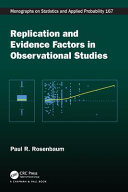Replication and Evidence Factors in Observational Studies 1st Edition by Paul R. Rosenbaum 9781000370034 1000370038
$50.00 Original price was: $50.00.$25.00Current price is: $25.00.
Replication and Evidence Factors in Observational Studies 1st Edition Paul R. Rosenbaum – Ebook Instant Download/Delivery ISBN(s): 9781000370034, 1000370038

Product details:
- ISBN 10: 1000370038
- ISBN 13: 9781000370034
- Author: Paul R. Rosenbaum
Replication and Evidence Factors in Observational Studies
Table contents:
I Background: Aspects of Causal Inference
1 Causal Inference in Randomized Experiments
1.1 A Randomized Experiment
1.2 Structure and Notation
1.3 Covariates and Outcomes
1.4 Causal Effects with Two Treatment Groups
1.5 Inference with Random Assignment
1.6 Randomization Tests for Continuous Outcomes
1.7 Confidence Sets for Causal Effects
1.8 The General Situation
1.9 Summary: Randomization Simplifies Causal Inference
1.10 Using R
2 Causal Inference in Observational Studies
2.1 How Are Observational Studies Different from Experiments?
2.2 Sensitivity Analysis
2.3 *Another Example of Sensitivity Analysis
2.4 Design Sensitivity
2.5 Summary: Biased Treatment Assignment
2.6 Using R
2.7 Exercises
3 Replication and Its Limits
3.1 Biases Can Replicate
3.2 Some Perspectives
3.3 Replications that Disrupt Some Potential Biases
3.4 Instruments and Replication
3.5 Summary: Replication Is Not Repetition
II Evidence Factors in Practice
4 Examples of Studies with Evidence Factors
4.1 Smoking and Periodontal Disease
4.2 Antineoplastic Drugs and DNA Damage
4.3 Lead Absorption in Children
4.4 Minimum Wages and Employment
4.5 Benzene and Chromosome Aberrations
4.6 Summary: Mutually Supporting, Unrelated Comparisons
4.7 Using R
4.8 Exercises
5 Simple Analyses with Evidence Factors
5.1 Structure of the Simple Analyses
5.2 Antineoplastic Drugs and DNA Damage
5.3 Smoking and Periodontal Disease
5.4 Factors that Do Not Concur
5.5 Summary: Strengthen Evidence of Cause and Effect
5.6 Using R
5.7 Exercises
6 Planned Analyses with Evidence Factors
6.1 Closed Testing with Three Factors
6.2 Confidence Intervals for Magnitudes of Effect
6.3 Evidence Factors Plus an Incompatible Comparison
6.4 Summary: Planned Analyses Can Accomplish More
6.5 Using R
6.6 Exercises
III Theory of Evidence Factors
7 Dependent P-Values
7.1 Dependent P-values Larger Than Uniform
7.2 Jointly Larger Than Uniform
7.3 Creating Jointly Valid, Possibly Dependent P-values
7.4 Combining Jointly Valid, Possibly Dependent P-values
7.5 Summary: Dependent P-values Jointly Larger Than Uniform
7.6 Exercises
8 Treatment Assignments as Permutations
8.1 Formalizing Intuition about Unrelated Pieces of Evidence
8.2 Individuals, Strata, and Treatment Positions
8.3 Permutation Matrices
8.4 Pick Matrices
8.5 Direct Sums of Permutation Matrices
8.6 Subpick Matrices
8.7 Treatments with Doses
8.8 Permuting Strata of the Same Size
8.9 Permuting Several Permutation Matrices
8.10 Doing Several Things at Once
8.11 Summary: A Treatment Assignment Is a Permutation
8.12 Complement: Split Matrices
8.13 Exercises
9 Sets of Treatment Assignments
9.1 Sets of Permutation Matrices
9.2 Products of Sets
9.3 Unique Representation as a Product of Two Factors
9.4 *Closure
9.5 Summary: Factoring Sets of Treatment Assignments
9.6 Exercises
10 Probability Distributions for Treatment Assignments
10.1 One Distribution
10.2 A Set of Distributions
10.3 *Some Technical Remarks and Definitions
10.4 Sensitivity Analysis
10.5 Summary: Probability on a Set of Treatment Assignments
10.6 Complement: Sensitivity Analysis with Doses
10.7 Exercises
11 Factors
11.1 Marginal and Conditional Distributions
11.2 Joint Distribution of Two Sensitivity Analyses
11.3 Sets of Marginal and Conditional Distributions
11.4 Ignoring a Factor
11.5 Conditioning on a Factor
11.6 Combining Two Sensitivity Analyses
11.7 Summary: Combining Two Sensitivity Analyses
11.8 Complement: More than Two Factors
11.9 Exercises
12 *Groups of Permutation Matrices
12.1 Why Groups?
12.2 Groups
12.3 Groups in Evidence Factors: Some Examples
12.4 Group Products
12.5 Summary: Groups Provide the Needed Factors
IV Aspects of Design
13 Constructing Matched Samples with Evidence Factors
13.1 Aspects of Design
13.2 Nearly Optimal Complete Blocks
13.3 Optimal Incomplete Block Designs
13.4 Variation in Treatment within and Between Institutions
13.5 Comparing Study Designs: Which Design Is Best?
13.6 Summary: Build Evidence Factors into the Design
13.7 Using R
14 Design Elements for Evidence Factors
14.1 Some Common Design Elements
14.2 *Symmetric Sets of Biases
People also search:
replication and evidence factors in observational
replication and evidence factors in observational studies pdf
observational evidence definition
observational evidence examples
replication experiment example
You may also like…
Computers - Programming
Medicine - Endocrinology
Uncategorized
Medicine - Others
Medicine - Endocrinology
DeGroot Endocrinology 8th Edition by Paul Robertson 9780323694148 0323694144
Business & Economics - Econometrics
Time Series Econometrics: Learning Through Replication 2nd Edition Levendis












